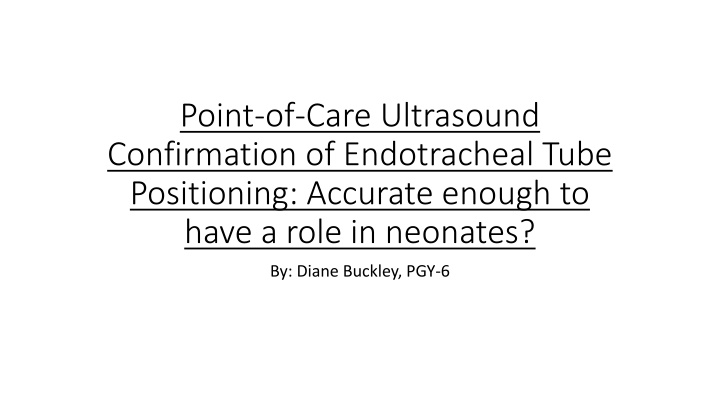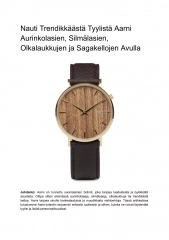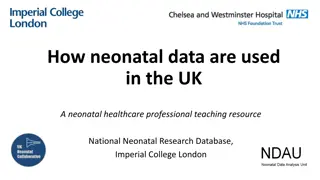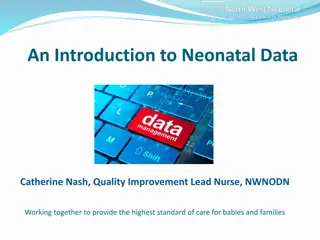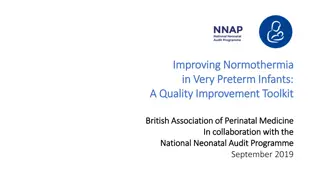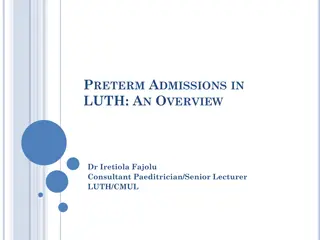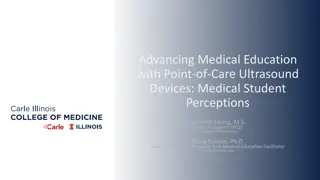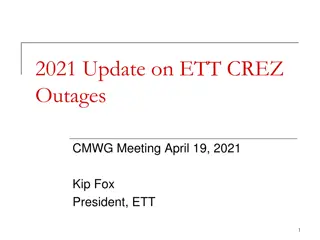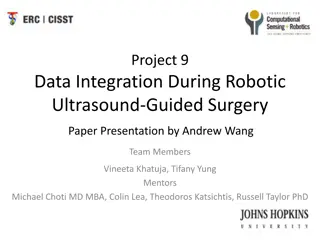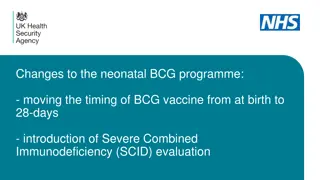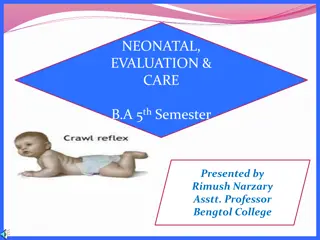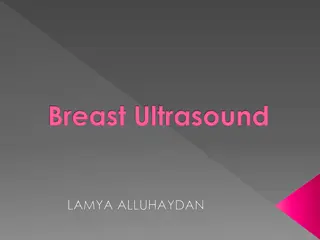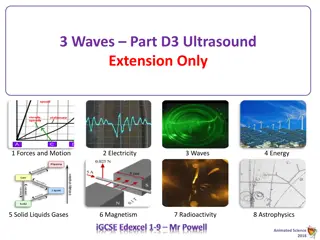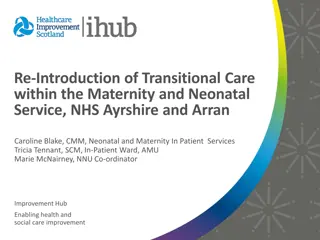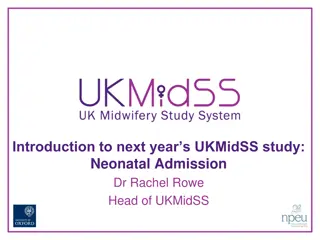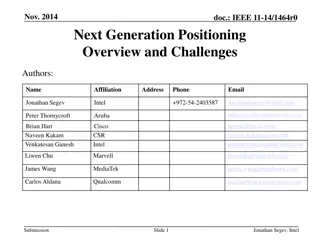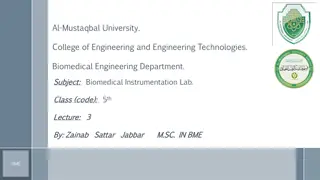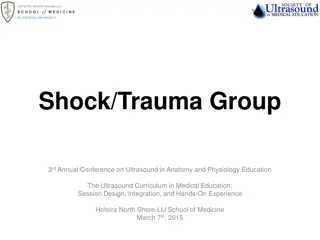Point-of-Care Ultrasound in Neonatal ETT Positioning
Point-of-care ultrasound (POCUS) is emerging as a potential tool for confirming endotracheal tube (ETT) positioning in neonates, providing a viable alternative to X-ray examination. The study aims to assess the accuracy of POCUS in determining ETT placement, particularly by using the superior aspect of the right pulmonary artery as a surrogate marker for the carina, with potential implications for reducing radiation exposure and improving rapid evaluation in neonatal intensive care units (NICU).
Download Presentation

Please find below an Image/Link to download the presentation.
The content on the website is provided AS IS for your information and personal use only. It may not be sold, licensed, or shared on other websites without obtaining consent from the author.If you encounter any issues during the download, it is possible that the publisher has removed the file from their server.
You are allowed to download the files provided on this website for personal or commercial use, subject to the condition that they are used lawfully. All files are the property of their respective owners.
The content on the website is provided AS IS for your information and personal use only. It may not be sold, licensed, or shared on other websites without obtaining consent from the author.
E N D
Presentation Transcript
Point-of-Care Ultrasound Confirmation of Endotracheal Tube Positioning: Accurate enough to have a role in neonates? By: Diane Buckley, PGY-6
Background Ultrasound is widely used in pediatrics as a primary imaging modality Point of care ultrasound (POCUS) is used in multiple pediatric subspecialties at bedside by physicians Becoming more widely available in NICU Broad list of potential uses
ETT positioning Gold standard = radiography XR not available in the delivery room Delay getting to bedside at times POCUS can be utilized at the bedside to evaluate proper ETT position Potential NICU specific uses Delivery room Prior to surfactant administration Rapid evaluation in cases of clinical deterioration Surveillance to limit radiation exposure
Anatomical considerations Sternum in neonates is cartilaginous in nature Helps with visualization Various studies use surrogate marker for the carina Aortic Arch >1 cm above is considered not deep Does require a measurement between the ETT and the aortic arch Superior border of the RPA Above is considered not deep
Anatomic overlay with Aortic Arch and Carina Anatomic overlay with RPA and Carina
Literature today Few studies in Neonates Most are small Minimal stratification across gestational ages Most studies included limited VLBW infants Most studies showed 90% concordance between x-ray and POCUS for not deep Carina surrogate marker varies Most studies utilize the Aortic Arch
My study objectives Primary: To determine if POCUS will agree with X-ray (gold standard) for ETT positioning in neonates <1 month of age across gestational ages utilizing the superior aspect of the RPA as a surrogate marker for the carina Secondary: Investigate interrater reliability by calculating a kappa coefficient for multiple non-expert ultrasonographers (Cindy Crabtree, DO and Diane Buckley, MD)
General Study Design Observational, prospective cohort study I was primary ultrasonographer Dr. Crabtree was secondary ultrasonographer US machine that was in the unit was utilized US images were obtained on days with previously scheduled x-rays Goal was to define tube on US as deep or not deep Deep: past the superior border of the RPA Not Deep: at or above the superior border of the RPA
Statistics Required 35 POCUS scanning encounters Allows us to conclude agreeability in >90% of encounters with a 10% margin of error Alpha 0.05, 95% confidence intervals Allows for calculation of inter-rater reliability Cohen s Kappa (unweighted)
Inclusion/Exclusion Criteria Inclusion NCH NICU Infants <1 month of age Intubated Exclusion Known cardiac malformation/congenital heart disease that affected vasculature Known trachea/airway malformation Significant anasarca or skin abnormalities precluding appropriate images Significant clinical instability
Study protocol Informed consent obtained Bedside US obtained within 3 hours of standard, pre-planned and clinically appropriate chest x-ray Used midsternal approach to visualize RPA and ETT tip Used linear probe for consistency Dr. Crabtree and I performed US independently, without discussion about imaging, and in succession Excel data collection sheet with locked tabs, so data remained blinded and saved to encrypted flash drive
Study Protocol Still images and movie clips obtained were saved to an encrypted USB drive POCUS images underwent a quality assurance review with Pediatric Cardiologist (Ashley Neal, MD) Anatomy verification Radiographs were independently evaluated by Pediatric Radiologist (Brittany Albers, MD) Used at or above the carina as not-deep Below carina as deep
Data collection Enrolled 15 patients between Sept 2022-Jan 2023 2 patients weren t able to be scanned prior to extubation 13 patients were scanned between 1-5 times Total 35 scans ETT always able to be seen on US All POCUS images performed within 2.5 hours of x-ray (only 3 were obtained >1 hour between)
Demographics Demographics n=13 Mean (SD) 27+5(38) 23.7 (4.8) 35.6 (8.1) 1138 (910) Range (min, max) 22+2, 37+3 18, 33 26.7, 50.8 365, 2860 Median 25+4 22.5 33 710 Gestational Age at Birth (Weeks + days) Birth Head Circumference (cm) Birth Length (cm) Birth Weight (g) ELBW (%) VLBW (%) SGA (%) AGA (%) LGA (%) M (%) F (%) 77% 0% 15% 85% 0% 54% 46% Birth Weight classification Sex
Demographics Gestational Age at Birth of Patients Enrolled 7 6 5 Number of Patients 4 3 2 1 220+246 250+276 35+ 280+306 310+346 0 22-24 25-27 28-30 31-34 35+ Gestational Age (weeks)
Demographics Birth Weight 9 8 7 6 Number of Patients 5 4 3 2 1 0 <500g 501-1000g 1001-1500g Birth Weight (g) 1501-2000g 2001-2500g >2500g
Respiratory Characteristics Respiratory Characteristics Ventilator Type CMV (%) HFV (%) Respiratory (%) Surgical (%) Neurological (%) 2.0 (%) 2.5 (%) 3.0 (%) 3.5 (%) 91.4% 8.6% 100.0% 0.0% 0.0% 5.7% 85.7% 2.9% 5.7% Primary Reason for Ventilation ETT size
Results Corrected Gestational Age on Day of Imaging 18 16 14 12 Number of Patients 10 8 6 4 2 0 220+246 250+276 35+ 280+306 310+346 22-24 25-27 28-30 31-34 35+ Corrected Gestational Age on Day of Imaging (weeks)
Results Weight on Day of Imaging 35 30 25 Number of Patients 20 15 10 5 0 <500g 501-1000g 1001-1500g 1501-2000g 2001-2500g >2500g Weight (g)
Results Number of Scans Each Patient Underwent 5 1 15% 23% 4 15% 3 2 16% 31% 1 2 3 4 5
Results Agreeability and Interrater Reliability Physician 2 Imaging Modality Rads Expert XR Rads Expert XR Neo 2 XR Neo 1 XR and own POCUS Neo 2 XR and own POCUS Neo 2 POCUS Physician 1 Neo 1 Neo 2 Neo 1 Neo 1 Neo 2 Neo 1 Agreement (%) Cohen's Kappa 100.0% 94.2% 94.2% 91.4% 100.0% 85.7% 95% CI (1,1) (0.78,0.86) (0.78,0.86) (0.68,0.76) (1,1) (0.53,0.63) 1.00 0.82 0.82 0.72 1.00 0.58
Conclusions POCUS is feasible for ETT depth determination in the NICU Valid across gestational ages and birth weights Generalizable for non-expert physician ultrasonographers Implementation of POCUS is easy POCUS safe no infants with adverse reactions or worsening clinical status after imaging
Limitations Small sample size X-ray requires repositioning of the babies Differing definitions of deep and not deep on radiograph interpretations Applicable only to infants with normal cardiac and airway anatomy
References Chowdhry, R, et al. The Concordance of Ultrasound Technique versus X-Ray to Confirm Endotracheal Tube Position in Neonates. Journal of Perinatology, vol. 35, no. 7, 2015, pp. 481 484., doi:10.1038/jp.2014.240. Cowan, Eileen, et al. Implementing Point of Care Ultrasound in the Neonatal Intensive Care Unit: a Safety Study. Journal of Perinatology, vol. 41, no. 4, 2021, pp. 879 884., doi:10.1038/s41372-021-00955-5. Dennington, Debra, et al. Ultrasound Confirmation of Endotracheal Tube Position in Neonates. Neonatology, vol. 102, no. 3, 2012, pp. 185 189., doi:10.1159/000338585. Jaeel, Pooja, et al. Ultrasonography for Endotracheal Tube Position in Infants and Children. European Journal of Pediatrics, vol. 176, no. 3, 2017, pp. 293 300., doi:10.1007/s00431-017-2848-5. Najib, Khadijehsadat, et al. Ultrasonographic Confirmation of Endotracheal Tube Position in Neonates. Indian Pediatrics, vol. 53, no. 10, 2016, pp. 886 888., doi:10.1007/s13312-016-0953-6. Saul, David, et al. Sonography for Complete Evaluation of Neonatal Intensive Care Unit Central Support Devices. Journal of Ultrasound in Medicine, vol. 35, no. 7, 2016, pp. 1465 1473., doi:10.7863/ultra.15.06104. Sethi, Ankur, et al. Point of Care Ultrasonography for Position of Tip of Endotracheal Tube in Neonates. Indian Pediatrics, vol. 51, no. 2, 2014, pp. 119 121., doi:10.1007/s13312-014-0353-8. Sharma, Deepak, et al. Role of Ultrasound in Confirmation of Endotracheal Tube in Neonates: a Review. The Journal of Maternal-Fetal & Neonatal Medicine, vol. 32, no. 8, 2017, pp. 1359 1367., doi:10.1080/14767058.2017.1403581. Sheth, Mansi, et al. Ultrasonography for Verification of Endotracheal Tube Position in Neonates and Infants. American Journal of Perinatology, vol. 34, no. 07, 2016, pp. 627 632., doi:10.1055/s-0036-1597846. Singh, Poonam, et al. Normative Data of Optimally Placed Endotracheal Tube by Point-of-Care Ultrasound in Neonates. Indian Pediatrics, vol. 56, no. 5, 2019, pp. 374 380., doi:10.1007/s13312-019-1533-3. Uya, Atim, et al. Point-of-Care Ultrasound in Sternal Notch Confirms Depth of Endotracheal Tube in Children*. Pediatric Critical Care Medicine, vol. 21, no. 7, 2020, doi:10.1097/pcc.0000000000002311. Zaytseva, Alla, et al. Determination of Optimal Endotracheal Tube Tip Depth from the Gum in Neonates by X-Ray and Ultrasound. The Journal of Maternal-Fetal & Neonatal Medicine, vol. 33, no. 12, 2019, pp. 2075 2080., doi:10.1080/14767058.2018.1538350.
Thank you! Dr. Crabtree Dr. Neal Dr. Albers Yana Feygin, Sharmin Sumy SOC members: Dr. Stewart, Dr. Fischer, Dr. Ruppe
